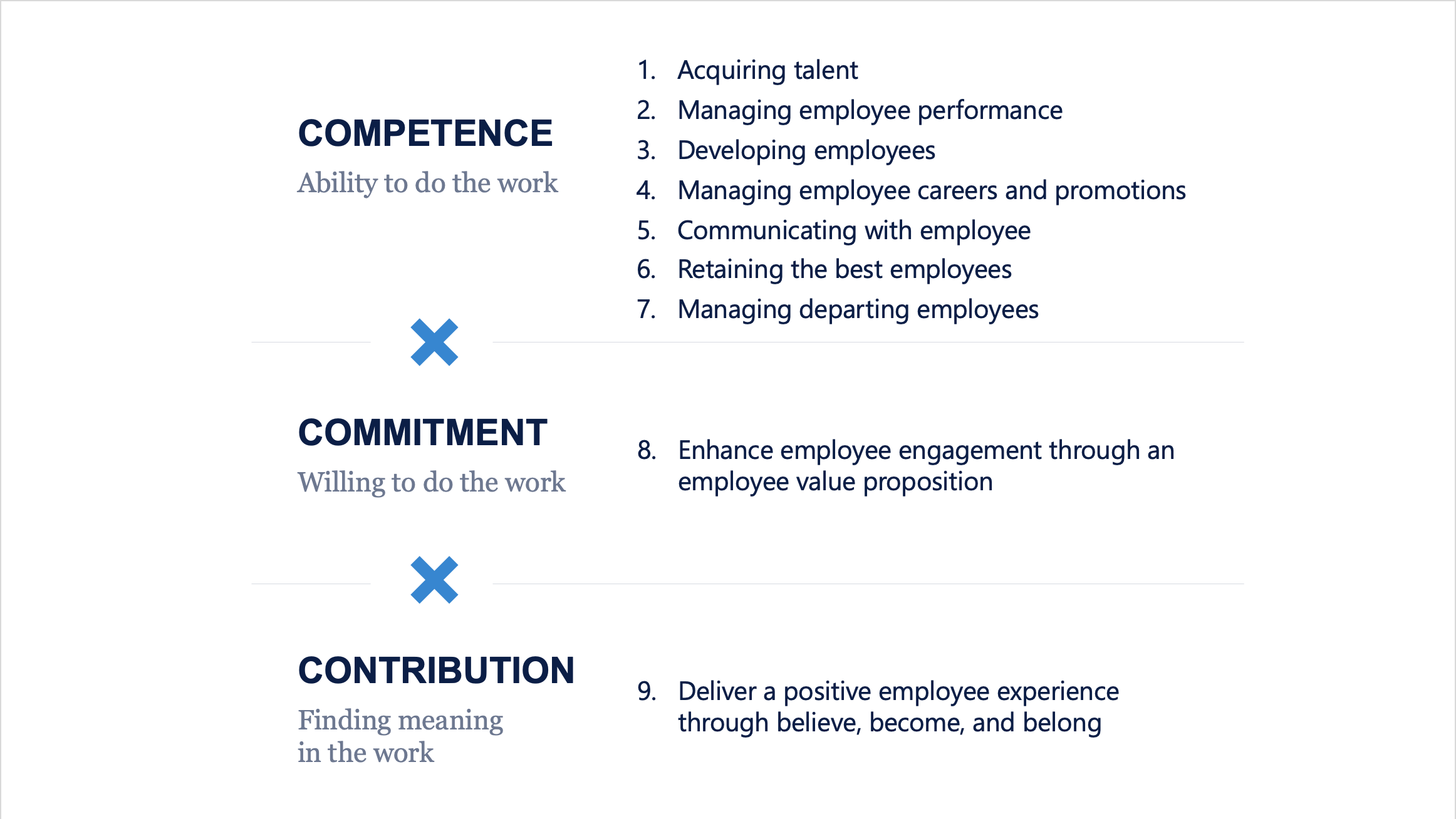How Do I Develop Better Talent?
Key Take-Aways:
- Building the workforce is the behavior that matters most for successful leaders at every level in the organization.
- To help leaders become more effective talent developers, RBL's Talent Academy uses a simple framework that includes: (1) achieving the right level of competence, (2) ensuring commitment through employee engagement, and (3) creating the right type of environment for employees to contribute.
- Leaders who build talent multiply their impact—they are able to do more by equipping and motivating their employees to deliver the outcomes that matter most.

How Do I Develop Better Talent?

“Leadership is easy—if you have the right people on the team. We want to figure out how do we get the right people on our team, with the right skills and the right commitment, then get out of their way."
– Dave Ulrich
Several years ago, we looked at data on 13,000 leaders from over 80,000 raters to better understand what leadership behaviors are the most important at each level of leadership. One of the key findings of this study was that the behaviors that mattered most for successful leaders at every single level in the organization were those related to building the workforce.
While the specific behaviors in this area did vary slightly from front-line to mid-level to executive leadership, there were some core commonalities:
First-line leaders:
- Develop the talent on their team but with an eye to the future.
- Provide resources to make sure they can develop and perform in their current roles.
- Coach their team members on what they need to do to succeed.
- Act as a talent magnet.
Mid-level leaders:
- Future-oriented development, coaching, and understanding of future critical roles, as described above.
- Facilitate collaboration and networking within the organization.
- Create alignment and support for future directions.
- Bridge expectations between executive and front-line leaders to both create alignment and understanding.
- Develop authentic respect and trust that creates high performance.
Executive leaders:
- Same as above, but with greater emphasis on future talent pools.
- Maintain an updated picture of what future talent needs will be—what are the talent implications of future strategic directions?
- Personally invest their time in helping key employees develop and advance.
- Ensure their own team is performing well.
Effective Talent Developer Framework
To help leaders become more effective talent developers, RBL uses a simple framework that includes: (1) achieving the right level of competence, (2) ensuring commitment through employee engagement, and (3) creating the right type of environment for employees to contribute.

1. Personalize Leadership
Personalize leadership. The great resignation is due in part to employees reacting to significant stressors in their lives. They are seeking environments that make it easier not harder to cope with the pressures in their lives. Great leaders first care for each person as an individual, one by one. It’s personal. A personalization agenda helps the people you coach to learn and discover opportunities from these crises all around us. As a leader who cares about a colleague, we customize what they need, and we coach them with guidance about their work. Leaders who know their teams and are regularly asking questions like: Where’s the place you want to work? What do you want to do and contribute? What are the working conditions that you need? When leaders lead out of this personal place, one by one, their employees have a better experience and are better able to and more willing to use their unique knowledge, skills, and abilities to deliver results that matter.
2. Acquire Talent
Great leaders have a concrete plan for the type of talent they need and the wisdom and discretion to identify, recruit, and hire talent that helps them win. For example, are you a Walmart needing operational efficiency orientation in your workforce, or are you an Apple, needing entrepreneurial innovation? With clarity about what you need, you can then set standards regarding who you need, source and screen appropriate candidates, secure through an offer of employment then socialize and onboard your candidate with the right skills and fit for your organization.
3. Manage Employee Performance
Once an employee is hired, great leaders proactively manage employee performance. They use four critical steps to establish positive accountability: (1) Clarify expectations – be clear about what is expected as outcomes of the role. (2) Establish metrics and standards and level and quality of effort. (3) Allocate resources to ensure appropriate support and financial and non-financial rewards (or consequences. (4) Engage in a positive conversation to coach employees to high performance.
4. Develop Employees
Great leaders invest in their teams. They are talent exporters who grow people that can replace them or move to other key roles across the organization. They magnify talent to prepare for bigger and better roles, identify the skills that people who work for them need to get better, know their career aspirations and coach them to help develop the skills they need, and provide clear and frequent feedback about their ongoing performance.
5. Encourage Diversity, Equity, and Inclusion
A leader’s job is to get and grow the best talent available, no matter where they come from or what they look like. Great leaders unleash the full power of the whole workforce as they strengthen others using their strengths and use their values to help others create their value. They unlock potential by proactively looking for ways to mentor and give opportunities to everyone. They recognize their unconscious biases and deliberately challenge themselves and others to set them aside. Leaders use their power to empower others and make diversity, equity, and inclusion a reality not just a slogan.
6. Communicate
Great leaders communicate for impact. They seek ways to disseminate information in positive ways throughout the organization. They have a clear message, are clear about their audience and how they want them to receive the message, time it appropriately, and are intentional about what communication method will be most effective.
7. Retain the Best Employees and Remove Non-Performers
Great leaders have always been astute about accurately identifying the best performers and knowing how to keep them while also being able to identify and move out lower performers. Great talent managers in today’s world do this in increasingly personalized ways. They know what motivates their best performers, how they feel recognized and rewarded, and are actively delivering on those expectations. They also know how to—and don’t hesitate to –effectively move out those who are not meeting expectations and do it in a way that helps everyone grow.
8. Improve and Track Employee Engagement
More broadly, great leaders are able to generate higher levels of employee engagement. They know what levers to pull to help employees engage more. They also know how to make sure that when people give more, they get more back.
9. Create a Positive Employee Experience, Well-being, and Mental Health
Employee experience is powerful when it drives other outcomes. It is not the goal, it is the way in which the organization is able to make strategy, customer, financial and community outcomes happen. Today’s employee experience is the evolution from motivation to satisfaction, to engagement, to commitment, to experience. Overall, do our employees have a consistent experience that is aligned with what we have promised at every step of the employee life cycle? Each interaction with employees by leaders should reinforce the employee value proposition and help employees have a great work experience.
Conclusion
By building skills in your leaders in these nine areas, you equip leaders throughout the organization to become powerful leaders. Organizations that invest in building leaders who build talent are building the kind of leaders who are able to deliver on customer, investor, and community promises. Leaders who build talent multiply their impact—they are able to do more by equipping and motivating their employees to deliver the outcomes that matter most.
If you are looking for ways to build leaders who build the workforce, consider RBL’s Talent Academy, now also delivered in Spanish.

